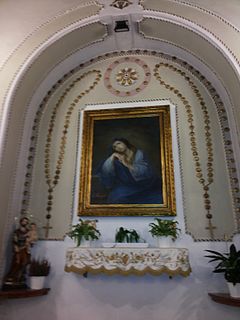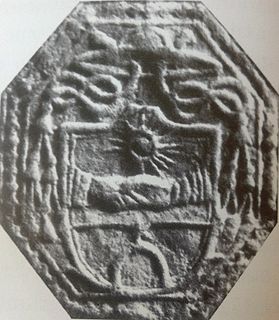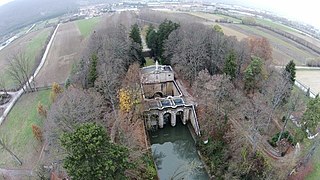
Avezzano is a city and comune with a population of 40,712 inhabitants, situated in the Abruzzo region, province of L'Aquila, Italy. It is the second most populous municipality in the province and the sixth in the region. Avezzano was documented as an existing urban center in the ninth century. The city was destroyed by the earthquake of 1915. It was rebuilt after the 1944 Allied bombing. The city was decorated with the silver medal for civil merit, an award granted by the Italian Republic.

Cappadocia is a comune and town with approximately 550 inhabitants in the province of L'Aquila in the Abruzzo region of central Italy. It is part of Marsica. It's also part of the "Borghi autentici d'Italia" club.

Ortona dei Marsi is a comune and town in the province of L'Aquila in the Abruzzo region of central Italy. It is included in traditional area of Marsica. The commune is part of the National Park of Abruzzo, Lazio and Molise. Ortona dei Marsi is situated on 1000 meters above sea level and the mountains that surround the valley reach up to 1,800 meters.

Marsica is a geographical and historical region in the Abruzzo, central Italy, including 37 comuni in the province of L'Aquila. It is located between the plain of the former Fucine Lake, the National Park of Abruzzo, Lazio and Molise, the plain of Carsoli and the valley of Sulmona.

Santuario della Madonna del Divino Amore, or the Shrine of Our Lady of Divine Love, is a Roman Catholic shrine in the southern outskirts of Rome dedicated to the Blessed Virgin Mary that consists of two churches: an old church built in 1745 and a new church added to the sanctuary in 1999. The church was included by Pope John Paul II in the pilgrimage of Seven Pilgrim Churches of Rome during the Holy Year 2000.

The Sanctuary of Madonna dei Miracoli is a church in Alcamo, province of Trapani, Sicily, southern Italy; it is dedicated to the Madonna of the Miracles.

Our Lady of Miracles is the patron saint of the town of Alcamo.

The Sanctuary of the Most Holy Mary of the Height is a place of Marian devotion, located on the top of Mount Bonifato, in Alcamo in the province of Trapani, Italy.

The cult of Maria Santissima della Confusione began in the province of Trapani, and eventually spread in the near province of Palermo.

Avezzano concentration camp was an Italian assembly and detention camp set up in 1916 in the Abruzzo city of the same name during World War I, immediately after the 1915 Marsica earthquake that almost completely destroyed it decimating the population. The detention camp was reserved to about 15,000 prisoners from the Austro-Hungarian army, mainly of Czech–Slovak, Polish, German, and Hungarian nationalities; Romanians, who were gathered in the Romanian Legion of Italy by the end of the conflict, had a garrison and a training camp in Avezzano. Mostly abandoned in 1920, a sector was reused in World War II to house Indian, English, New Zealand, and Pakistani war prisoners.

Monte Salviano is a massif in the Abruzzo Apennines, Central Italy. It includes the peaks of Monte d'Aria, Monte Cimarani and Monte San Felice. Since 1999 the area, falling within the municipal territory of Avezzano, has been included in the Riserva Naturale di Monte Salviano.

The Piani Palentini are a plateau in upper Marsica, a subregion of Abruzzo, in central Italy.

Muzio Febonio was an Italian priest and historian, best known for his historical and agiographic works about Marsica, the Abruzzo sub-region where he was born. In his writings he made extensive use of archive documents and historiographic and archaeological sources, showing a deep knowledge of them, although in a somewhat formal and pedantic style. However, his works represent a valuable source of information for later historians, even if their publication occurred with a lot of errors and delays, which partly explains the limited fame this author enjoyed.

Madonna di Pietraquaria is one of the titles by which the Holy Virgin Mary is venerated as the Patroness of the city of Avezzano, in Abruzzo, Italy. On 1 January 1978, Maria Santissima di Pietraquaria was proclaimed the patroness saint of the city of Avezzano. The Virgin Mary is celebrated with events and religious rites between 25 and 27 April.

The Tunnels of Claudius are a hydraulic work made up of a long underground canal, six inclined service tunnels and thirty-two wells, which Emperor Claudius had built between 41 and 52 AD to control the variable levels of the Fucine Lake in Abruzzo, thus protecting riparian villages from floods and reclaiming the Fucine lands making them cultivable. Thanks to them, the lake waters flowed out through the belly of Mount Salviano from the Avezzano side along the almost 6-kilometre-long (3.7 mi) tunnel until they flowed into the Liri River on the opposite side of the mountain, under the old town of Capistrello. The underground canal represents the longest tunnel ever built since ancient times until the inauguration of the Fréjus Rail Tunnel occurring in 1871.

The Fucine Inlet is a monument built on the head of the main emissary of the Fucine Lake in Italy. It is made up of the three-arched bridge of the sluice gates and the about 7-metre-high (23 ft) statue of the Immaculate Conception rising above. It is situated in Borgo Incile, a locality south of the city of Avezzano, in the Fucine plain, Abruzzo, Central Italy. The facility necessary for the drainage of the Fucine Lake connects the outer drainage canal to the underground emissary which is served by the system of the Tunnels of Claudius in Mount Salviano. The monument was made in 1876 by architect Carlo Nicola Carnevali.

The Riserva Naturale di Monte Salviano or Riserva naturale guidata Monte Salviano is a nature reserve in Abruzzo, Italy, established in 1999. It lies in the territory of the comune (municipality) of Avezzano, in the Province of L'Aquila. The reserve is named after Monte Salviano, a massif that extends northwest to southwest dividing the Fucine basin from the Palentine Plains, in the Marsica sub-region.

The Capistrello massacre was a mass killing carried out in Capistrello, a small town in Abruzzo, Italy, on 4 June 1944 by Nazi and Fascist occupation troops during World War II. A first tragical episode occurred a few months earlier on 20 March, when a local youth was barbarically tortured and then shot. The following roundup made by Nazists and Fascists on the slopes of Mount Salviano led to the capture and torture of 33 shepherds and breeders. The shooting occurred near Capistrello railway station.

The sanctuary of Madonna del Ponte is located on the SP 63, in the territory of Partinico (Palermo), 3 or 4 km from the junction of Balestrate of the A29 motorway.

The Sanctuary of Santa Maria della Consolazione is a Roman Catholic Marian Sanctuary church located at the end of via Provvidenza Virgillito Providenza, on a hill-top South-West of Paternò in Sicily. It is also known as the Santuario della Madonna Santissima della Consolazione.

























